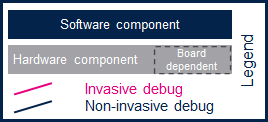Registered User No edit summary |
Registered User mNo edit summary |
||
| Line 1: | Line 1: | ||
The block diagram below shows the {{highlight|'''STM32MP1 Platform trace and debug environment'''}} components and their possible interfaces: | The block diagram below shows the {{highlight|'''STM32MP1 Platform trace and debug environment'''}} components and their possible interfaces: | ||
| Line 41: | Line 33: | ||
* By selecting a '''host software component''', you will be redirected to an article that explains how to use this remote tool. | * By selecting a '''host software component''', you will be redirected to an article that explains how to use this remote tool. | ||
{{ImageMap|Image: STM32MP1 Platform trace and debug environment overview.png{{!}} thumb{{!}} 800px {{!}} center {{!}} STM32MP1 Platform trace and debug environment overview. | {{ImageMap|Image: STM32MP1 Platform trace and debug environment overview.png{{!}} thumb{{!}} 800px {{!}} center {{!}} STM32MP1 Platform trace and debug environment overview. | ||
rect 128 0 363 63 [[How to get Terminal|Remote shell]] | rect 128 0 363 63 [[How to get Terminal|Remote shell]] | ||
rect 402 0 637 63 [[GDB]] | rect 402 0 637 63 [[GDB]] | ||
| Line 65: | Line 57: | ||
}} | }} | ||
[[File:STM32MP1 Platform trace and debug environment overview legend.png|center|link=]] | [[File:STM32MP1 Platform trace and debug environment overview legend.png|center|link=]] | ||
<noinclude> | |||
{{PublicationRequestId | 9565 | 2018-11-12 | AnneJ}} | |||
[[Category:Trace and debug tools|0]] | |||
</noinclude> | |||
Revision as of 16:14, 15 October 2019
The block diagram below shows the STM32MP1 Platform trace and debug environment components and their possible interfaces:
- The STM32MPU Embedded Software package (see STM32MPU Embedded Software architecture overview) that includes:
- The OpenSTLinux BSP and application frameworks components, running on the Arm® Cortex®-A core
- The STM32Cube MPU Package running on the Arm® Cortex®-M core
- The STM32MPU peripherals shared between Cortex®-A and Cortex®-M cores (such as GPIO, I2C and SPI)
- The user interfaces or tools, which allow to interact with different trace and debug Tools, such as:
- The remote shell using terminal console
- The debugger tools (such as GDB)
- The graphical IDE (such as GDBGUI or SystemWorkbench)
- The trace and debug interfaces or hardware paths that provide access to trace and debug components through:
- The network interface (e.g. Ethernet)
- The communication port (e.g UART)
- The hardware connector interfaces:
- JTag port
- Trace port to access ETM, STM, ITM and SWD
- I/O probes to access HDP
- The hardware probes such as ST-Link.
This block diagram also illustrates the Arm® debugging modes:
- Invasive debug: debug process that allows the control and monitoring of the processor. Most debug features are considered invasive because they enable you to halt the processor and modify its state.
- Non-invasive debug: debug process that allows the monitoring of the processor but not the control. The embedded trace macrocell (ETM) interface and the performance monitor registers are non-invasive debug features.
Click the figure below to directly jump to the component you want to trace, monitor or debug:
- By selecting a hardware component, you will be redirected to the corresponding hardware board article in order to check if the hardware connector is supported on your board.
- By selecting a target software component, you will be be redirected to an article that explains in details how to trace, monitor or debug this component.
- By selecting a host software component, you will be redirected to an article that explains how to use this remote tool.

